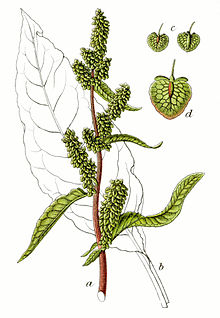Even with little agricultural knowledge, most of us understand we cannot have the most bountiful crops without pollination. Its part of the cycle – its how most plants function – it’s the purpose of many plant parts, birds and insects.
It’s often the bane of allergy sufferers. Since plants have pollen, we tend to blame all plants (some have been given a bad rap for years). If you have seasonal allergies, you may want to research pollen more thoroughly prior to developing your yard.
Most seasonal allergens come from native plants and folks tend to put them in the category of “weeds”. They grow in our roadsides and vacant lots – happily spreading their little pollen fluff balls (yes, fluff balls is my totally unscientific term) on the wind.
One sure rascal is Rumex spp known to locals as Sorrel or Dock. They are in a genus of about 200 species of annual, biennial and perennials in the buckwheat family. The allergenicity of this weed is moderate to high. Bad news it pollinates from April through September. Even if you pull or kill every single piece on your property – the pollen is known for spreading widely on the wind. This pollinator just doesn’t know when to leave a good party.

I call Sorrell or Dock a weed, but it is actually an herb. There are male and female plants having no greater thrill than distributing the pollen so as to reproduce. It’s such an adaptable plant, it grows over most of this continent and others except the most cold or arid.

In fairness, through the years this plant has had many uses and has been cultivated for centuries:
- The leaves may be pureed in soups and sauces or added to salads. It has the flavor similar to kiwifruit or sour wild strawberries. The plant’s sharp taste is due to oxalic acid, which is a poison. In small quantities sorrel is harmless; in large quantities it can be fatal.
- R. obtusifolius or Butter dock’s large leaves were used to wrap and conserve butter.
- R. hymenosepalus is a source of tannin used for leather tanning and the stems used for mustard-colored dye.
- Dock leaves are traditionally a remedy for the sting of nettles.
- So long standing, it is used over much of the world in native dishes and drinks.
If you use manure on your gardens, chances are you will be pulling dock for quite some time. It does have a long tap root so make sure you pull it as soon as it pops its little head out of the ground.
Silphium terebinthinaceum (of the aster family) is Prairie Dock and an Illinois wildflower (you know those pretty little yellow daisy-like flowers seen on roadsides.) It is not known to cause allergies.
In Illinois, we can’t limit or contain wind born allergens – there are too many and many grow wild. If you are mildly or a short term sufferer of seasonal allergies, you may just need mild or temporary methods of dealing. If you suffer a more severe reaction, you may want to become close friends with an allergist. Wearing a mask, limiting your time outdoors, watching http://www.pollen.com and using air conditioning might help. The severity of your symptoms, the effectiveness of your treatments and your desire to garden are considerations.
“They know, they just know where to grow, how to dupe you, and how to camouflage themselves among the perfectly respectable plants, they just know, and therefore, I've concluded weeds must have brains." - Dianne Benson, "Dirt"
Pollen photos: aaaai.org



No comments:
Post a Comment